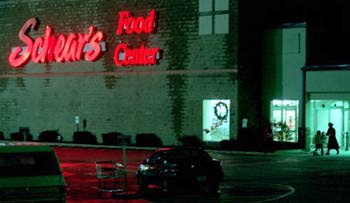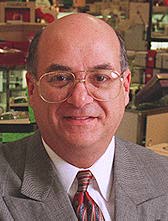
The year in business
1997 was a profitable year for some, devastating for others
while GM stayed in
the news throughout the year
GENERAL MOTORS CORP.
 General Motors Corp. was a newsmaker all year as it laid plans
for a major expansion of its Moraine truck plant, moved toward a
possible deal to turn its engine plant over to Isuzu and prepared to
spin off its Delphi parts division.
General Motors Corp. was a newsmaker all year as it laid plans
for a major expansion of its Moraine truck plant, moved toward a
possible deal to turn its engine plant over to Isuzu and prepared to
spin off its Delphi parts division.
|
Published: Sunday, December 28, 1997
By Timothy R. Gaffney
DAYTON DAILY NEWS
Privatization hit Wright-Patterson Air Force Base. General Motors said it
will spend millions in Moraine. Merger mania gripped Miami Valley companies
large and small. And some venerable chief executives called it quits.
Area companies generated a landslide of news in 1997.
The shrinking military establishment continued to trigger reorganizations
and cutbacks at Wright-Pat, Ohio's biggest single-site employer with about
22,000 civilian and military workers. But defense conversion efforts continued
showing positive results at Gentile Station in Kettering and the Mound Plant
in Miamisburg.
General Motors Corp. was a newsmaker all year as it laid plans for a major
expansion of its Moraine truck plant, moved quietly toward a possible deal to
turn its engine plant over to Isuzu and prepared to spin off its giant Delphi
parts division.
Elder-Beerman Department Stores' struggle to recover from bankruptcy at
times looked more like a tug-of-war between the Beerman family, which wanted
to keep control of the retail chain, and creditors that wanted to sell off its
assets to other chains.
January
The old Gentile Air Force Depot, once the home of the Defense Electronics
Supply Center, officially closed at the end of 1996 and greeted the new year
as the Kettering Business Park. In the ensuing months, Kettering transformed
the drab, concrete military depot into a landscaped site, its cavernous
warehouses mostly hidden behind modern facades. Government and commercial
tenants moved 1,800 jobs to the site and filled more 60 percent of its 1.5
million square feet of indoor space. More than 200 government and business
leaders officially opened the park in November.
Gayston Corp., a Springboro company that makes automobile air bag parts and
weapons components, was fined more than $1 million in January after federal
prosecutors charged the company with conspiracy to rig bids for weapons parts
and money laundering. Three individuals received prison sentences.
February
General Motors Corp. officials confirmed for the first time that four of
their Dayton-area plants were losing money and would be sold or shut down if
company and union officials couldn't agree on a plan to make the plants
profitable. J.T. Battenberg III, president of Delphi Automotive Systems, GM's
large parts division, said two Dayton brake plants and two other Delphi
Chassis plants in Kettering were in trouble because of financial losses and
tough competition. Local union leaders were finally able to reach agreements
with the world's largest automaker this past summer, but the plants were not
expected to show a profit for 1997. Job security and plant closing rumors
plagued GM's local work force for most of this year.
March
For the first time, General Motors Corp. reported separate financial
results for Delphi Automotive Systems, making its parts supplier division look
more than ever like a separate company. Additional moves followed throughout
the year, including plans to sell 20 percent of the division to public
stockholders in 1998. GM's actions increased pressure on Delphi's Dayton
operations to be profitable or face cuts. Delphi, the world's largest maker of
auto parts, operates six plants in the Dayton area with about 14,000 hourly
workers.
April
A sharp drop in first quarter profits prompted Electronic Data Systems
Corp. in April to launch a major job review that could eliminate 9,000 of the
Texas-based company's 100,000 positions. The computer services company employs
1,200 in the Dayton area.
LEE SCHEAR
 Lee Schear, the former Dayton grocer who founded SuperPetz six
years ago, resigned as president of the fast-growing pet supplies
chain. Schear, 45, lost his Schear's Metro Markets chain in December
1996 after defaulting on loans.
Lee Schear, the former Dayton grocer who founded SuperPetz six
years ago, resigned as president of the fast-growing pet supplies
chain. Schear, 45, lost his Schear's Metro Markets chain in December
1996 after defaulting on loans. |
May
Wright-Patterson Air Force Base officials in May cut the ribbon on a new
supercomputer center which they said would change the way researchers invent
weapons and bolster Wright-Pat's role as a major military research center. The
so-called Major Shared Resource Center is one of four that form the hubs of a
new nationwide military supercomputer network. Community leaders said the new
center will also help draw top research talent to the area.
Lee Schear, the former Dayton grocer who founded SuperPetz six years ago,
resigned as president of the fast-growing pet supplies chain. It was the
second dose of negative news for Schear, 45, who lost his Schear's Metro
Markets chain in December 1996 after defaulting on loans.
 In June, Second and Main Ltd., a group of 20 corporations that
bought the vacant Lazarus store in July 1995, decided to consider
redeveloping the block into apartments after a $113 million
hotel-office tower-performing arts center drew little interest.
In June, Second and Main Ltd., a group of 20 corporations that
bought the vacant Lazarus store in July 1995, decided to consider
redeveloping the block into apartments after a $113 million
hotel-office tower-performing arts center drew little interest. |
June
Second and Main Ltd., a group of 20 corporations that bought the vacant
Lazarus store in July 1995, decided to consider redeveloping the block into
apartments after a $113 million hotel-office tower-performing arts center drew
little interest. But by year end nothing much had happened. Still, Second and
Main officials remained optimistic.
NCR Corp. made headlines throughout the year, but not always with good
news. The company continued posting losses, causing analysts to trim their
first-half estimates in June. In August, health authorities learned a contract
worker had exposed NCR's headquarters staff to tuberculosis, forcing a massive
screening that turned up 26 positive exposures - but no active TB cases -
among 283 employees. In October, the company announced its second work force
shake-up in three years with plans to cut 1,000 jobs from its worldwide work
force of 38,500. In December it ended its long manufacturing heritage with a
$100 million deal to have California-based Solectron Corp. build its cash
registers and computers. The sale freed NCR from a low-margin arena to focus
on software development, a move that pleased analysts.
July
The National Center for Composite Systems Technology got a big boost in
July when the Air Force's Wright Laboratory awarded it a $7.2 million contract
to test low-cost manufacturing methods for aircraft parts. The center is a
local initiative aimed at using Wright Lab technology to create manufacturing
jobs. It was already setting up to test a new method for mass-producing
vehicle structures from glass fibers and plastic resin. Another breakthrough
in composite technology came in July when Butler County, working with Wright
Lab, installed Ohio's first all-composite, glass fiber highway bridge.
Economy the story of the year
Published: Sunday, December 28, 1997
By JIM DILLON
It's the evening before Christmas Eve. The daily business page has been
edited and put to bed. I've got A Charlie Brown Christmas by the Vince
Guaraldi Trio playing on my office Macintosh, filling my ears with smooth
holiday jazz. All my colleagues have gone home and the place is quiet. Now is
the proper time to review 1997 and pick its most remarkable stories and
newsmakers.
Story of the year: The booming economy. As we reported Dec. 17 under the
headline "It's the best of times," the local and national economies have
performed exceptionally well this year. Housing starts are up. Mortgage rates
are low. Inflation is down. Unemployment levels are at record lows. Crime is
down, too. It seems nearly everyone benefited. I don't see how the economy can
get much better. Still, I know this won't last forever. The Asian crisis
continues to fester and there are signs that retail sales are softening.
Newsmaker of the year (company): This is a tough one. It's a difficult
choice between Elder-Beerman Stores Corp., which generated a ton of news this
year as the Moraine-based retailer prepares to emerge from two years of
bankruptcy, and General Motors Corp., whose local plants and employees were
the focus of numerous stories. But there can't be two winners, so the edge
goes to GM because its operations affect more people than those of
Elder-Beerman. Still, we will watch both closely in 1998. Elder-Beerman will
be a publicly traded company again, and GM will surely make some crucial
decisions about several plants here.
Newsmaker of the year (individual):

Mershad |
Fred Mershad, president and chief
executive of Elder-Beerman. A quick check of our electronic library shows that
Mershad's name appeared in at least 31 stories since he was name to his
current posts in January. That's a lot of ink. Sure, his name was bound to
appear a lot in print as he helped steer the retailer through the final stages
of bankruptcy. Still, I'm hard-pressed to find another individual who played a
larger public role in a major ongoing story.
Who-da-thunk-it story of the year: The battle for International Union of
Electronic Workers Local 801. Dayton is a big union town, so we're used to
writing stories about strife between union and management. But the struggle
between Local 801's president George Dunaway and the union's international
leaders for control of Dayton's largest union local (8,000 members) came
straight out of the blue. No one would have anticipated such a story in this
day and age. The dispute will come to a head in U.S. District Court soon.
A close second: The overthrow of Wes Wells as president of IUE Local 775.
Trend of the year: Mergers and acquisitions. By my count, at least a
dozen Miami Valley companies either acquired other companies this year or were
gobbled up by bigger fish. It was eat or be eaten. The deals involving locally
based companies ranged from Standard Register Co.'s $245 million purchase of
Uarco of Japan to several itty-bitty deals by the likes of small but
fast-growing Miami Computer Supply and Dayton Superior. Economists say we can
expect more mergers and acquisitions if the economy keeps chugging along.
A close second: Consolidation and privatization at Wright-Patterson Air
Force Base, a major employer with about 22,000 civilian and military workers.
My gut tells me 1998 will be a memorable year for Wright-Pat.
|
August
Babcock & Wilcox of Lynchburg, Va., replaced Boston, Mass.-based EG&G as
the Energy Department's contractor for the Mound Plant. The contract was
valued at $425 million during the next five years. The company's mission is to
finish cleaning up the former nuclear weapons plant and make the site ready
for transition to commercial use. Miamisburg has been working with the Energy
Department and state and local agencies to redevelop the 306-acre site into a
high-tech industrial park named the Mound Advanced Technology Center.
Word leaked that GM was considering a major expansion of its truck assembly
plant in Moraine. Insiders said the expansion would exceed $355 million and
might ultimately total close to $800 million. The Kettering-Moraine school
board approved a $6 million tax break, after members wrested an apology from
the automaker for allowing the board to believe the expansion might go
elsewhere without the break. GM didn't officially announce the expansion until
December.
September
The Salem Mall felt the first blow of a one-two punch when the J.C. Penney
department store chain announced it would close its Salem Mall store at the
end of 1997. The retailer had experienced major sales declines. The second
blow came in December when Lazarus officials announced they would close their
Salem Mall store after the Christmas shopping season. That would leave only
Sears as a major retailer in the mall.
The Air Force made the first flight test of its F-22 advanced Stealth
fighter at its Lockheed Martin Corp. assembly plant in Marietta, Ga. The
flight marked the culmination of years of work by hundreds of program office
workers at Wright-Patterson Air Force Base. Major features include Stealth and
supersonic cruise.
Spectra-Physics Laserplane of Huber Heights was merged with three other
companies to make Spectra Precision. The new company, headed by former
Spectra-Physics President Steve Berglund, has 1,300 employees, with 600 in the
Dayton area. Spectra Physics makes laser and sonic-based leveling, aligning
and grade-control systems for construction.
New York computer hardware distributor Global DirectMail Corp. bought
Infotel Inc. of Fletcher for $48.3 million. The acquisition was expected to
add jobs at the Fletcher plant. Infotel and its catalog business, MidWest
Micro, were to keep their names under the deal. Infotel, with about 480
employees, makes build-to-order personal computers.
October
Dayton opened a 36-acre business park at Webster Street and Stanley Avenue
with plans for a 40,000-square-foot U.S. Postal Service sorting center and
several commercial tenants.
Wright-Patterson Air Force Base officials selected two contractors to take
over support functions of the 88th Air Base Wing and the Wright Research Site,
formerly Wright Laboratory, replacing nearly 500 military and civilian Air
Force workers. The contracts went to Raytheon Support Services, a unit of
Burlington, Mass.-based Raytheon Co., and AdTech Systems Research Inc., a
private Beavercreek company. Their combined bid of $44.8 million promised
nearly $7 million in savings.
The Air Force opened the Air Force Research Laboratory headquarters at
Wright-Patterson Air Force Base, consolidating the administration of the Air
Force's four major laboratories. The new lab also consolidated 22 major
branches, known as directorates, into nine, with five at Wright-Pat. The
change was part of the Air Force's effort to cope with tighter budgets and a
shrinking work force.
Steven C. Mason retired as chairman and chief executive officer of
Dayton-based Mead Corp., Dayton's sole remaining Fortune 500 company. Mason
spent more than 40 years with the forest products company, including the last
five as chairman and chief executive officer. He was succeeded by Jerome F.
Tatar.
November
Hourly workers at General Motors Corp.'s Moraine Engine plant approved a
new local agreement that sets the stage for Isuzu Motors Ltd. to assume
control of the factory. The agreement implements a three-tier wage scale for
the plants 530 hourly workers and gives the plant an advantage in attracting
new work for Isuzu or other automakers, officials said.
A rift erupted between international leaders and some local officers of the
International Union of Electronic Workers Local 801. The national leaders
ousted local president George Dunaway after disagreements over some local
officials. The displaced officers went to U.S. District Court in December,
seeking an injunction to restore their power. The union represents about 8,000
hourly workers at three Dayton area GM plants. Elsewhere, labor talks yielded
contracts with more job security for workers in several of GM's local Delphi
plants in 1997.
Drugstore wars expanded as chains Revco and Rite Aid added more local
stores and Walgreens prepared to enter the market with four stores. Local
independent drugstore owners felt added pressure from the giant chains.
Kenneth W. Fletcher, who co-founded West Carrollton-based Roberds Inc. in
1971 and guided it to a 25-store chain with $342 million in annual sales,
resigned unexpectedly as president and chief executive after more than a year
of disappointing sales and sagging stock prices. Fletcher, 65, said he was
ready to retire after 26 years.
Lexis-Nexis President and Chief Executive Ira T. Siegel, 53, left his job
abruptly just weeks after announcing a reorganization plan aimed at keeping
the online database company ahead of Internet competitors.
After quietly fighting a potential takeover for more than a year,
Elder-Beerman Stores Corp. won a major victory that would let the retailer
emerge from Chapter 11 bankruptcy free of hostile threats. The agreement
prevents Carson Pirie Scott and Proffitt's from attempting a takeover of the
Moraine-based chain at least until Jan. 31, 1999. In December, a bankruptcy
judge approved Elder-Beerman's reorganization schedule.
Cleveland-based TRW Inc. announced it will buy McLean, Va.-based BDM
International for nearly $1 billion, including a local BDM operation that
employs about 250 people. Most of BDM's work focuses on Wright-Pat and other
federal work, although is also has a $27.5 million contract with Dayton Public
Schools to upgrade and manage computers and software.
December
Standard Register Co., the Dayton-based maker of business forms and
electronic documents, agreed to buy Uarco Inc., a wholly owned subsidiary of
Settsu Corp. of Osaka, Japan, by the end of the year for $245 million.
Standard Register President and Chief Executive Peter S. Redding said the
acquisition will result in some initial downsizing at both companies to
eliminate duplicate jobs. But, he said, he expects the number of Dayton-based
jobs to go up. About 900 of Standard Register's 6,400 workers are based in
Dayton.
Dayton-based Price Brothers Co., whose British subsidiary has provided
supplies for Libya's Great Man-Made River Project, came under fire when
published reports suggested the pipeline is instead becoming a secretive,
underground military network to conceal Libyan leader Moammar Gadhafi's
activities from American spy satellites. Price Brothers officials say its U.S.
operations haven't had any involvement with the project in 10 years.
Cleveland-based National City Corp. announced it will buy First of America
Bank Corp. for about $7.1 billion in stock. The merger will make it the
country's 13th largest bank, with $74.4 billion in assets.
Richard L. Molen decided to end 30 years with Miamisburg-based Huffy Corp.
when he retired as chairman and chief executive officer of the world's largest
bicycle maker. Succeeding Molen is Don R. Graber, president and chief
operating officer, who was hired 18 months ago as Molen's successor.
 General Motors Corp. was a newsmaker all year as it laid plans
for a major expansion of its Moraine truck plant, moved toward a
possible deal to turn its engine plant over to Isuzu and prepared to
spin off its Delphi parts division.
General Motors Corp. was a newsmaker all year as it laid plans
for a major expansion of its Moraine truck plant, moved toward a
possible deal to turn its engine plant over to Isuzu and prepared to
spin off its Delphi parts division.
 General Motors Corp. was a newsmaker all year as it laid plans
for a major expansion of its Moraine truck plant, moved toward a
possible deal to turn its engine plant over to Isuzu and prepared to
spin off its Delphi parts division.
General Motors Corp. was a newsmaker all year as it laid plans
for a major expansion of its Moraine truck plant, moved toward a
possible deal to turn its engine plant over to Isuzu and prepared to
spin off its Delphi parts division.
 Lee Schear, the former Dayton grocer who founded SuperPetz six
years ago, resigned as president of the fast-growing pet supplies
chain. Schear, 45, lost his Schear's Metro Markets chain in December
1996 after defaulting on loans.
Lee Schear, the former Dayton grocer who founded SuperPetz six
years ago, resigned as president of the fast-growing pet supplies
chain. Schear, 45, lost his Schear's Metro Markets chain in December
1996 after defaulting on loans. In June, Second and Main Ltd., a group of 20 corporations that
bought the vacant Lazarus store in July 1995, decided to consider
redeveloping the block into apartments after a $113 million
hotel-office tower-performing arts center drew little interest.
In June, Second and Main Ltd., a group of 20 corporations that
bought the vacant Lazarus store in July 1995, decided to consider
redeveloping the block into apartments after a $113 million
hotel-office tower-performing arts center drew little interest.